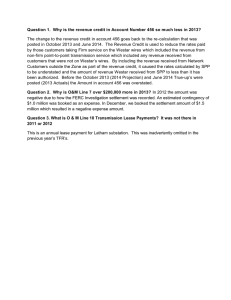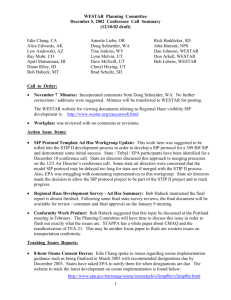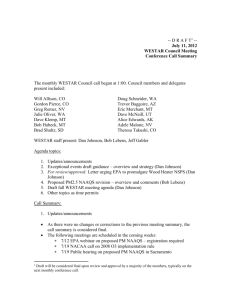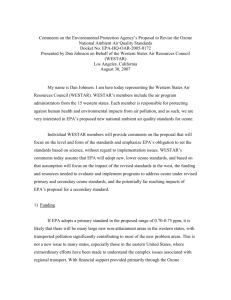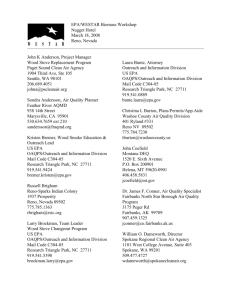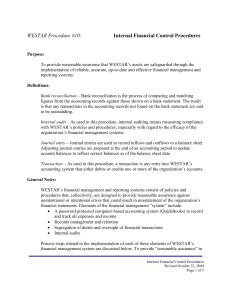Comments on EPA's draft National Monitoring Strategy
advertisement
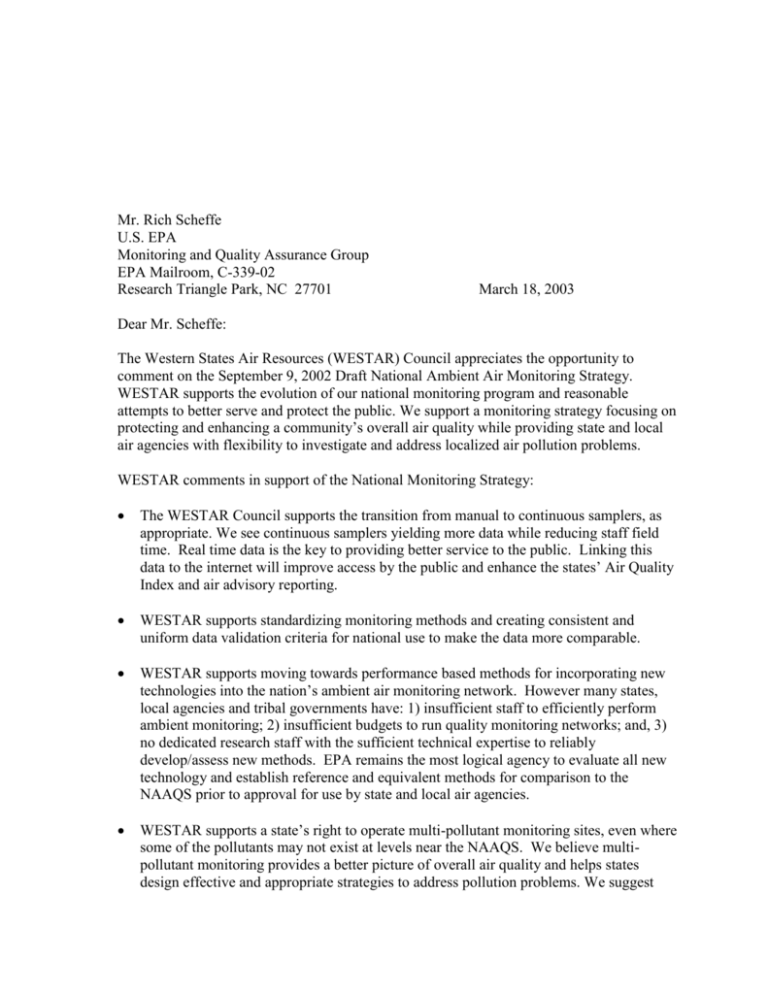
Mr. Rich Scheffe U.S. EPA Monitoring and Quality Assurance Group EPA Mailroom, C-339-02 Research Triangle Park, NC 27701 March 18, 2003 Dear Mr. Scheffe: The Western States Air Resources (WESTAR) Council appreciates the opportunity to comment on the September 9, 2002 Draft National Ambient Air Monitoring Strategy. WESTAR supports the evolution of our national monitoring program and reasonable attempts to better serve and protect the public. We support a monitoring strategy focusing on protecting and enhancing a community’s overall air quality while providing state and local air agencies with flexibility to investigate and address localized air pollution problems. WESTAR comments in support of the National Monitoring Strategy: The WESTAR Council supports the transition from manual to continuous samplers, as appropriate. We see continuous samplers yielding more data while reducing staff field time. Real time data is the key to providing better service to the public. Linking this data to the internet will improve access by the public and enhance the states’ Air Quality Index and air advisory reporting. WESTAR supports standardizing monitoring methods and creating consistent and uniform data validation criteria for national use to make the data more comparable. WESTAR supports moving towards performance based methods for incorporating new technologies into the nation’s ambient air monitoring network. However many states, local agencies and tribal governments have: 1) insufficient staff to efficiently perform ambient monitoring; 2) insufficient budgets to run quality monitoring networks; and, 3) no dedicated research staff with the sufficient technical expertise to reliably develop/assess new methods. EPA remains the most logical agency to evaluate all new technology and establish reference and equivalent methods for comparison to the NAAQS prior to approval for use by state and local air agencies. WESTAR supports a state’s right to operate multi-pollutant monitoring sites, even where some of the pollutants may not exist at levels near the NAAQS. We believe multipollutant monitoring provides a better picture of overall air quality and helps states design effective and appropriate strategies to address pollution problems. We suggest EPA encourage (or not discourage) states wishing to establish “ multi-criteria pollutant (or non criteria pollutant) monitoring super sites” which more fully characterize overall environmental health, and to do so with technical and fiscal assistance. WESTAR concerns regarding the National Monitoring Strategy: The WESTAR states are concerned that a revised National Monitoring Strategy may have an adverse impact on western state air quality monitoring networks by shifting resource priorities to the higher population areas. The infusion of PM2.5 103 Grant funding saved many under-funded state and local air monitoring programs. Recent focus on network assessments which significantly reduce the number of sampling sites in a state’s monitoring networks could have profound impacts on the number of trained staff and quality of collected data. These reductions will have the greatest impact in states with small monitoring staffs, widespread monitoring networks and small, remotely scattered communities. Their pollution focus may be different than the larger communities, their funding needs per capita or monitoring site may be greater and they may have more trouble bringing new monitoring methods on-line. Their training costs may be more and rising equipment costs will consume a greater percentage of their budget. Any loss of the PM2.5 dollars could reduce their limited staff and degrade their capacity. We wish to emphasize that the consequences of losing one person can have a significant and disproportionate, adverse impact on the overall monitoring program. We point out that just following EPA monitoring guidance would have ignored many small Western communities in the past and these communities would never had the benefit of the non-attainment and SIP process to clean up their air. We believe the PM2.5 problems need to be well characterized in these communities to ensure public health is not being jeopardized. The WESTAR Council recommends that monitoring dollar savings remain with the states. Decisions on how to use this money could be a negotiated grant item. Our states know best what their highest priorities are. Most states have monitoring priorities not currently being addressed due to insufficient funding. We have concerns about the operation of continuous, non-FRM/FEM samplers in areas with the potential for elevated concentrations without a collocated FRM on site. Different continuous samplers have different performance biases that could increase the uncertainty in air quality measurements and potentially lead to false conclusions about an area’s attainment status. Unless site specific correlations have been made, it seems unwise to shift to continuous samplers. Note that recent fire impacts have occurred in “attainment areas” where past performance implied concentrations less than 80 percent of the standard. EPA may want to make periodic, FRM collocated sampling a requirement to confirm site-specific correlations. Collocated FRM correlations may also be needed during peak events, such as forest fires, which could easily impact areas we normally consider in attainment. If modeling is used to help design monitoring networks, the models should also undergo periodic, field validation. The Western States are concerned that the L1-L3 monitoring classification scheme may disadvantage states in the West, especially those communities with small population centers and huge geographical areas. Rural communities deserve to have their environmental concerns addressed also. The revised monitoring strategy’s plan to use modeling to determine the location of a state’s L2 sites may not work well in the more remote or mountainous areas of the West. In fact, as mentioned above, past efforts to locate areas of concern using population as the primary key would have ignored many of the areas States found to be in non-attainment. Bio–terrorism, or other terrorist threats, poses a threat to America and there is nothing in this document which addresses our collective needs to conduct monitoring. The Office of Homeland Security and EPA have engaged states to become involved in some form of new monitoring. Manual samplers are widely available, but will not provide the “realtime’ information needed to protect the public. Data dissemination will be a key factor in protection of the public if we ever have an event. The monitoring networks may have to be extensive, possibly requiring multiple sites in each community. The National Monitoring Strategy should address this type of monitoring, but as currently drafted, does not. It should address the role of the states in this type of monitoring and identify potential trade-offs to the existing monitoring network. The new national monitoring strategy will address data validation for criteria pollutants, but not for meteorological parameters. Because of the importance of meteorology to air quality modeling, we recommend that EPA establish data validation criteria requirements for meteorological parameters. EPA currently operates several monitoring programs which don’t appear to be part of the National Monitoring Strategy, for example, the National Dioxin Air Monitoring Network (NDAMN), CASTNET and IMPROVE. We recommend that all monitoring be fully evaluated under the National Monitoring Strategy, that the strategy once completed be fully funded and that most if not all monitoring be performed through the states. Thank you again for this opportunity to comment on the National Ambient Air Monitoring Strategy. If you have any questions about our comments or suggestions, please contact WESTAR Technical Committee chair Gerry Guay from Alaska at (907) 269-3070 or WESTAR Technical Coordinator Bob Lebens at (503) 387-1660. Sincerely, Dan Johnson, Executive Director
